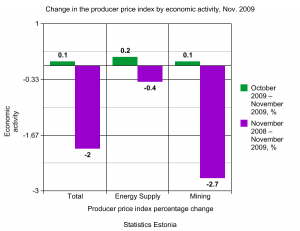TALLINN — Producer prices in Estonia are up from October but still down 2 percent year-on-year, according to the country’s Department of Statistics.
The producer price index, which measures the average change in selling prices that domestic producers receive for their products, rose by 0.1 percent compared to October but was still 2 percent lower than Nov. 2008.
The index’s rise from last month was propelled by the price uptick of timber over the last month and the continued increase of mining costs, which is 10 percent higher than in Nov. 2008 and 0.2 percent higher than this October.
The export price index increased by 0.2 percent compared to October 2009 but is 3.6 percent lower than in Nov. 2008. This was largely influenced by a price hike in the clothing industry, forestry and timber, but also by a price decrease in food and textile industry. Meanwhile the import price index increased 2.1 percent comparing the price in October, but decreased by 1.2 percent compared to Nov. 2008. and was influenced by the price increase of mineral fuels, forestry and wood products and the price drop in metal products and food products, according to Statistics Estonia.
According to Sander Klaos, director of department of analysis at Nordea’s Estonia subsidiary, the prices may have increased by 0.1 percent but comparing to the same period last year, the decrease is still 2.7 percent.
“Mainly the low prices in food production are behind the annual price decrease, but monthly price increase is influenced by improved external demand,” Klaos told Baltic Reports.
Internal recovery or external good fortune?
Maris Lauri, a senior analyst of Estonia’s largest bank Swedbank, the price index increase from October indicates green shoots of recovery in the country’s economy, hard-hit by the crisis.
“The main reason for the price increase is the slight recovery in the economy,” Lauri told Baltic Reports. “Most of Estonia’s industrial production goes for export, therefore the price has to be competitive.”
However, Karel Lember, an economic analyst in the Ministry of Economic Affairs and Communications is certain that the increase is mainly affected by the price decrease slowdown of different components.
“The prices of raw materials in world market have been stable or even have increased a little,” Lember told Baltic Reports.
Martin Lindpere, economist of the Bank of Estonia points out that grand conclusions should not be made based on the small-scale index rise.
“Longer term processes which show that producer price has been in a fall for quite awhile should be paid attention to,” Lindpere told Baltic Reports. “This is what shows the economic situation in Estonia and in the world.”
Like Lember, Lindpere thinks that producer prices are mainly influenced by the prices of raw materials and the load of production capacity.
“The increase in the prices of raw materials lately have been assisted by the rise of wood prices and the prices in energy depend on the situation of energy suppliers on the world market,” Lindpere said.













